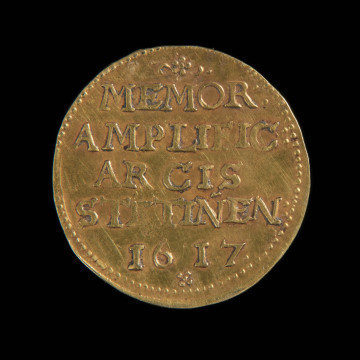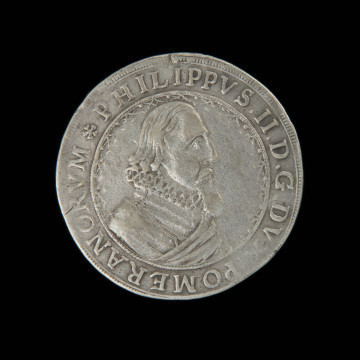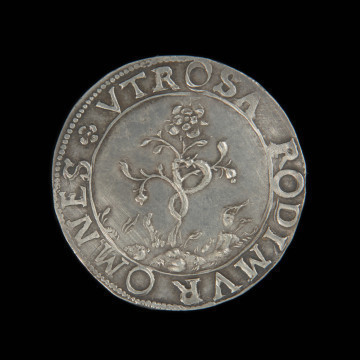
Commemorative guilder
1617
National Museum in Szczecin
Part of the collection: Pomeranian coins
The real heyday of occasional issues took place during the reign of Duke Philip II of Szczecin (1606-1618), a great patron of the arts and a collector. Coins were usually minted to commemorate the deceased dukes and important members of the House of Griffin. In 1616, a series of coins commemorating the death of Duchess Anna, the widow of Bogislaw XIII, was issued, and another one was minted to commemorate the untimely death of George III in 1617. Incredibly original coins appeared after the death of Duke Philip II in 1618. We are dealing with a tribute paid to his deceased brother by his successor - Francis I. The coins featured traditional compositions, such as the bust of the deceased on the obverse and a multiline legend on the reverse, and original images, such as skulls and scythes, and sentences hitherto unrelated to his passing, i.e., flowers and the sun. Among the legends, the reference to the education and virtues of Philip II is unusual. The content of this coin is reduced to a kind of hourglass, which contains a portrait of the deceased ruler and basic genealogical information. The coin weighing four thalers was minted with thaler's stamps. The same stamps were also used to make pieces of a half thaler (in the collection of the National Museum in Szczecin) and a double thaler. The obverse was stamped with a stamp previously used to produce other non-dated commemorative thalers. These were specimens with a griffin and shields on the wings, thalers with oval shields in a wreath, and thalers with a sailing boat at sea. The Duke’s portrait does not deviate from the conventional profile shot, and the armour with a sash emphasises the qualities of chivalry of Philip II. The DS initials placed under the ruler's arm indicate Daniel Sailer, an Augsburg goldsmith and medallist employed by the Szczecin mint to produce stamps. The quadruple thaler, though not astonishingly decorative, is a scarce specimen. We do not know how many were minted, but currently, the only extant and publicly available specimen is in the collection of the National Museum in Szczecin.
Genowefa Horoszko
Author / creator
Dimensions
cały obiekt: height: 8.3 mm, diameter: 42.2 mm
Object type
commemorative coin
Technique
minting
Material
silver
Creation time / dating
Creation / finding place
Owner
National Museum in Szczecin
Identification number
Location / status

1617
National Museum in Szczecin

1618
National Museum in Szczecin

1618
National Museum in Szczecin
DISCOVER this TOPIC
Castle Museum in Łańcut
DISCOVER this PATH
Educational path